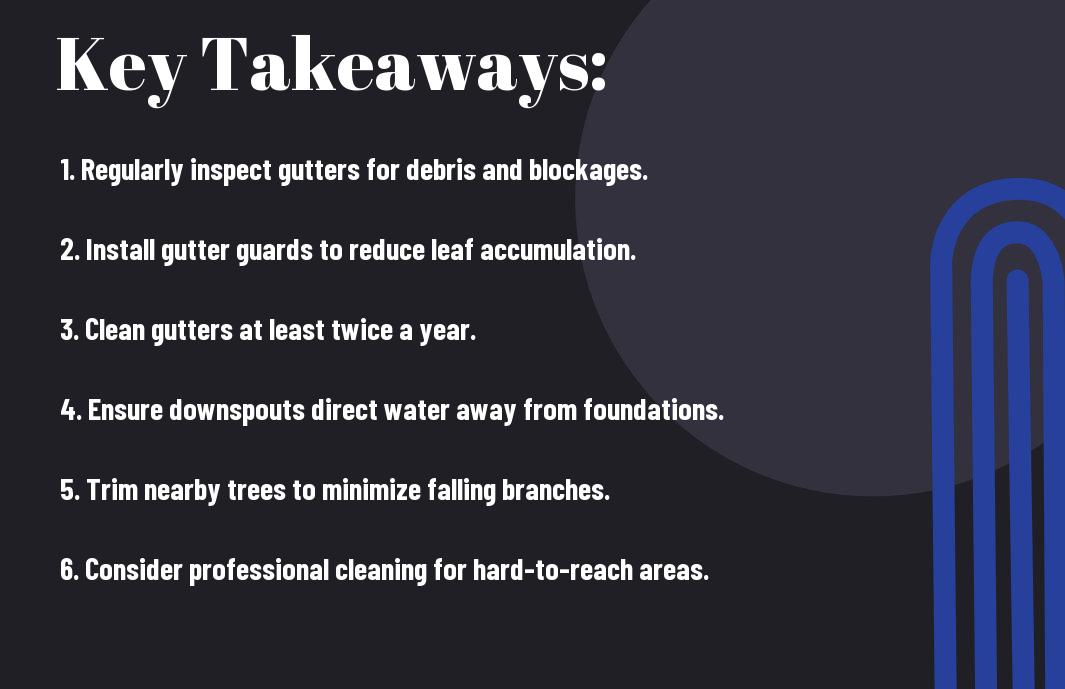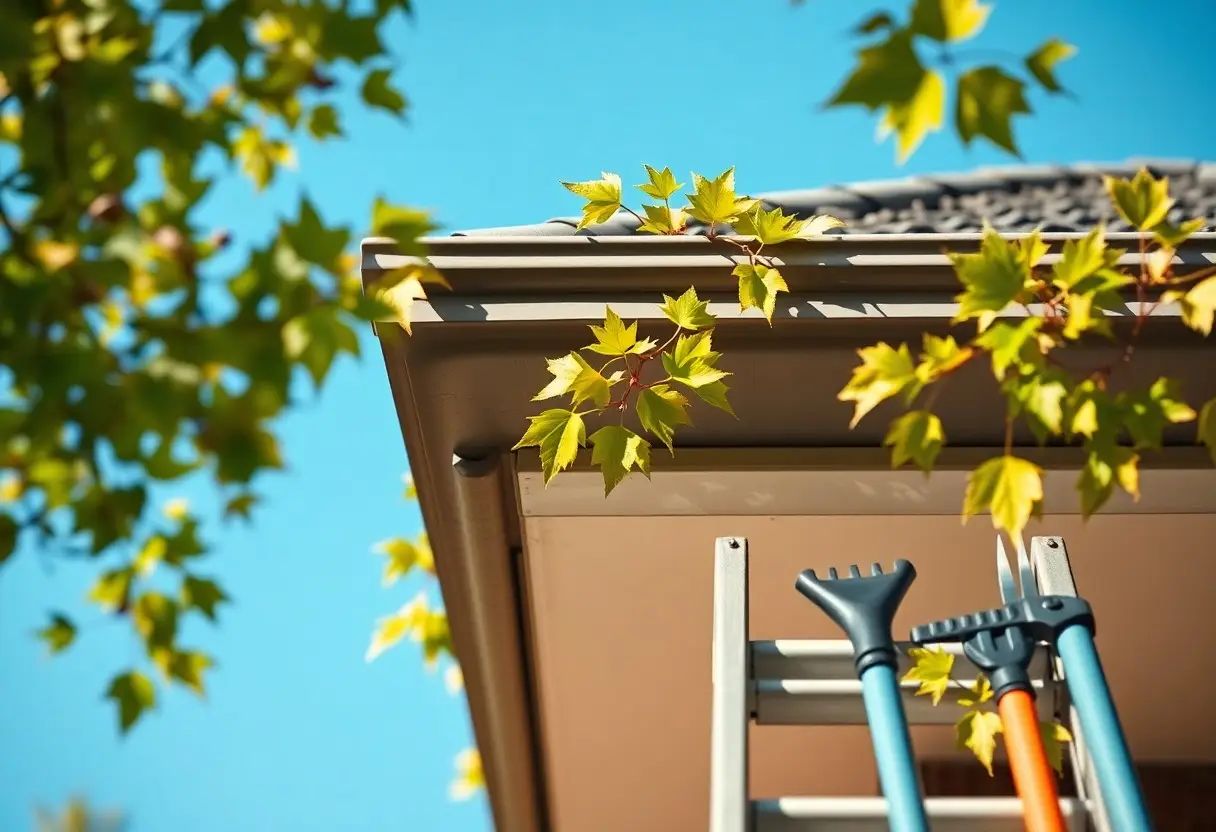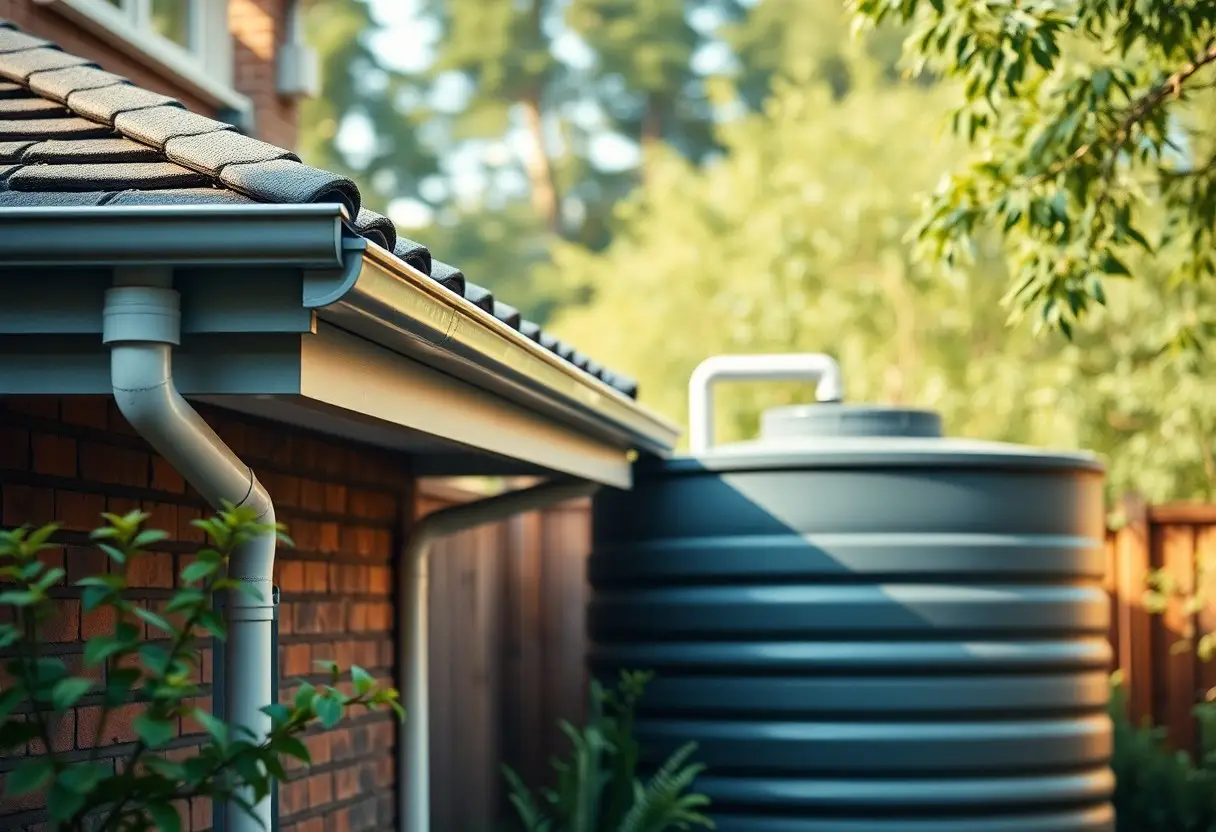It’s necessary for you to take proactive measures to maintain your gutters and prevent clogs that can lead to serious damage. Clogged gutters can cause water overflow, leading to foundation issues and costly repairs. In this post, you’ll discover five proven steps that will empower you to keep your gutters clear and functioning effectively. With these simple, actionable strategies, you can protect your home and enhance its longevity while ensuring that rainwater is directed away from your property.
Key Takeaways:
- Regularly inspect and clean gutters to prevent blockage from leaves and debris.
- Install gutter guards to minimize the amount of debris that can enter the gutter system.
- Ensure downspouts are clear and direct water away from the foundation to avoid overflow issues.
Understanding Gutter Clogs
To effectively prevent gutter clogs, it’s important to understand what causes them. Gutter clogs occur when leaves, twigs, debris, or even nesting animals accumulate in your gutters, obstructing the flow of water. This blockage can lead to water overflowing, damaging your home’s foundation, siding, or landscaping. By grasping the nature of these clogs, you can take proactive measures to keep your gutters clear and functioning properly.
Common Causes of Gutter Clogs
Understanding the typical culprits of gutter clogs can help you stay ahead of the problem. Common causes include falling leaves in autumn, granules from asphalt shingles, twigs, dirt, and small animal nests. Each of these elements can accumulate over time, leading to significant blockages that disrupt drainage and can result in costly repairs.
The Importance of Gutter Maintenance
To keep your home safe from potential water damage, regular gutter maintenance is important. By routinely cleaning and inspecting your gutters, you can drastically reduce the risks associated with clogs, such as foundation issues and mold growth.
This routine upkeep not only enhances your gutter system’s effectiveness but also protects your property’s value. A well-maintained gutter system prevents costly repairs that arise from water damage. Scheduling regular inspections and cleanings ensures that your gutters remain clear and functional, allowing rainwater to flow freely and safeguarding your home from potential hazards.

Step 1: Regular Gutter Cleaning
While it may feel like a tedious chore, regular gutter cleaning is an imperative step to prevent clogs in your drainage system. Keeping your gutters free of debris ensures that water can flow freely and protects your home from potential water damage. By establishing a consistent cleaning schedule, you can maintain the health of your gutters and avoid costly repairs in the future.
Tools Needed for Cleaning
The right tools can make your gutter cleaning job easier and more effective. Equip yourself with a sturdy ladder, gloves, a scoop or trowel for removing debris, a bucket for collecting waste, and a garden hose to flush out the gutters afterward. Safety is key, so make sure your ladder is stable, and consider using a safety harness if you’re working on a multi-story home.
How Often to Clean Your Gutters
To maintain optimal function, you should clean your gutters at least twice a year—once in the spring and once in the fall. However, if you live in an area with many trees or experience severe weather, you may need to clean them more frequently to prevent buildup.
Also, be aware of your environment, as seasonal changes can impact how often you should clean your gutters. Heavy tree coverage might necessitate more frequent cleanings, especially in the fall, when leaves can clog your gutters. Similarly, after storms or in rainy seasons, inspect your gutters for debris or blockages. By staying proactive and adapting your cleaning schedule to your surroundings, you can effectively safeguard against clogged gutters and the costly damage they might cause.
Step 2: Installing Gutter Guards
Keep your gutters flowing smoothly by investing in gutter guards. These protective barriers can drastically reduce the amount of debris that enters your gutters, making them much easier to maintain over time. By filtering leaves, twigs, and other materials, gutter guards help prevent blockages that can lead to water damage in your home.
Types of Gutter Guards
- Mesh guards: Block small debris while allowing water to flow through.
- Screen guards: Designed with larger openings to filter debris.
- Reverse curve guards: Direct water into the gutter but allow leaves to fall off.
- Foam inserts: Sit inside your gutters and allow water to pass while blocking debris.
- Micro-mesh guards: Offer the finest filtration for minimal upkeep.
Against many common headaches of gutter maintenance, gutter guards present a reliable solution that keeps your gutters clean and protected.
Benefits of Gutter Guards
With gutter guards installed, you can enjoy reduced maintenance, less potential for water damage, and longer lifespan for your gutters. They minimize the need for regular gutter cleaning, saving you time and effort. Additionally, by preventing clogs, they reduce the risk of water damage to your foundation and landscaping. Investing in gutter guards can also eliminate the hazards of climbing ladders to clean your gutters.
To truly appreciate the advantages of gutter guards, consider how they mitigate serious issues over time. By significantly decreasing the buildup of debris, you lower the likelihood of clogs, which can lead to expensive repairs. More importantly, premier gutter guards can protect your home from the damaging effects of water leaks and mold growth, ensuring a safer and healthier environment for you and your family.

Step 3: Proper Downspout Configuration
Now that you understand the basics of gutter maintenance, it’s time to focus on proper downspout configuration. Ensuring that your downspouts are adequately placed and functioning efficiently is vital for directing water away from your home’s foundation, which can prevent long-term damage and costly repairs.
Importance of Downspout Placement
Any homeowner must prioritize the correct placement of downspouts. If downspouts are misaligned or positioned too close to your home, they can direct water back towards your foundation. This improper routing may lead to soil erosion, flooding, and moisture-related issues in your basement or crawlspace.
Strategies to Ensure Effective Drainage
An effective drainage system starts with strategically positioned downspouts that lead to well-established drainage pathways. To achieve this, you should evaluate your landscape to identify appropriate outlets for runoff, such as storm drains or gravel areas. Consider installing extensions on your downspouts to direct water at least 5 to 10 feet away from your home’s foundation. Regularly inspect these outlets for blockages and ensure they remain functional to enhance your drainage system’s effectiveness.
Importance: Proper downspout configuration significantly impacts your home’s safety and the longevity of its structure. By routing water away from your foundation, you minimize the risk of foundation cracks, flooding, and mold development. Additionally, installing downspout extensions helps safeguard your landscape from erosion and preserves your yard’s aesthetic. Failure to address downspout placement may lead to expensive repairs and long-term damage, so prioritizing this step is vital for maintaining your home’s integrity.
Step 4: Landscaping Considerations
Not all landscaping choices are created equal when it comes to gutter clog prevention. By being mindful of your garden setup, you can minimize the risk of clutter making its way to your gutters. Choose plants that are low-maintenance and produce less litter, and strategically think about the locations of trees and shrubs, as their leaves and debris can quickly pile up and lead to blocked gutters.
Choosing the Right Plants
The selection of plants can significantly impact your gutter maintenance. Opt for species that are native to your area, as they usually require less care and produce fewer leaves and other debris. Ground covers and perennial plants can provide greenery without adding to your gutter woes.
Managing Leaves and Debris
Any landscape design will require ongoing attention to leaf and debris management. You can maintain your gutters by keeping a routine that includes regular cleaning, especially during fall. Placing your plants thoughtfully will also help direct debris away from your roofline.
Leaves from surrounding trees can pose a substantial risk to your gutter system. Regularly check your gutters for clogs, especially after windy or stormy weather. Employing mulch around garden beds can also help manage the spread of leaves, while keeping the soil stable and preventing excess debris from reaching your gutters. If your landscape is heavily treed, consider investing in guard systems to help keep leaves out of your gutters and maintain proper water flow.
Step 5: Seasonal Inspections
Once again, conducting seasonal inspections is key to maintaining clear gutters and preventing clogs. By regularly assessing your gutters, you can identify potential problems before they escalate into costly repairs. Make it a habit to inspect your gutters at least twice a year, preferably during the spring and fall, when debris accumulation is most prevalent.
What to Look for in Inspections
Among the critical factors to assess during your inspections are the presence of leaves or other organic material, signs of rust or corrosion, and any loose or sagging sections. Make sure to check downspouts for blockages and ensure that water flows freely away from your foundation.
When to Schedule Professional Help
Below, if you notice extensive damage, persistent clogs, or if you’re uncomfortable performing inspections yourself, it might be time to call in a professional. A trained technician can thoroughly examine your gutter system, ensuring it functions optimally and lowering the risk of hazardous water damage.
In addition, seeking professional help is vital if you observe significant issues, such as water pooling around your foundation or water seeping into your walls. These signs can indicate serious problems that need immediate attention. Hiring a professional can also provide you with peace of mind, knowing that experts are handling the situation and taking the necessary steps to protect your home from potential structural damage.
Are the Proven Steps for Gutter Clog Prevention Different from the Simple Steps?
While both proven and simple steps aim to protect your gutters, their effectiveness can differ. Proven steps for gutter clog prevention involve regular maintenance and strategic installations like gutter guards. In contrast, simple steps might include occasional cleaning. For optimal results, combining both gutter clog prevention steps is advisable.
Final Words
To wrap up, ensuring the maintenance of your gutters is imperative for the longevity of your home. By following these five proven steps for gutter clog prevention, you can significantly reduce the risk of damaging blockages and costly repairs. Regular cleaning, installing gutter guards, checking downspouts, trimming surrounding foliage, and scheduling professional inspections will empower you to take control of your home’s drainage system effectively. Prioritizing these actions will not only protect your property but also enhance its overall value.
FAQ
Q: What are the common causes of gutter clogs that can be prevented?
A: Common causes of gutter clogs include falling leaves, twigs, and debris from trees, as well as bird nests and moss growth. Regular maintenance, such as frequent cleaning and trimming overhanging branches, can significantly reduce the likelihood of these materials accumulating in your gutters.
Q: How often should I clean my gutters to prevent clogs?
A: It is recommended to clean your gutters at least twice a year, ideally in the spring and fall. If you have many trees near your home, you may need to clean them more frequently, possibly every few months, to ensure they remain clear of debris and function effectively.
Q: What additional preventative measures can I take to enhance gutter performance?
A: Installing gutter guards or screens can help keep leaves and debris out of your gutters while still allowing water to flow freely. Additionally, ensuring proper downspout installation and positioning can help direct water away from the foundation of your home and reduce the risk of clogs by encouraging efficient drainage.


